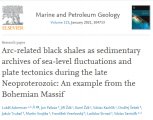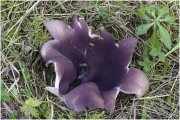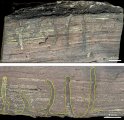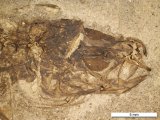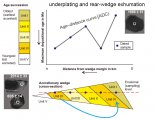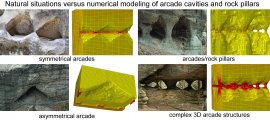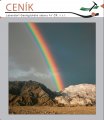News archive
News older than one year.
Ancient sea-level fluctuations due to vast glaciations
Black shales provide important clues to paleoenvironmental changes of the Earthʼs oceans and atmosphere throughout the geological history. In the Bohemian Massif, black shales were commonly deposited at, or very close to, the Neoproterozoic/Cambrian boundary, also known as the period of “Life Explosion”. The new study led by Lukáš Ackerman of the Institute of Geology and published in the Marine and Petroleum Geology journal (link here) focused on two black shale successions. It revealed that their deposition was intimately connected with the waning activity of a volcanic arc, changes in anoxic-oxic conditions and a global sea level change in response to large-scale periods of glaciation between 580 and ~550 Ma.
Is arsenic responsible for the toxicity of the Violet Crown Cup?
The Violet Crown Cup, Sarcosphaera coronaria, is a nicely coloured spring mushroom. In earlier days, the mushroom was considered edible, but several poisonings were reported in the early 20th century. The reason for the sporadic toxicity of S. coronaria is still unknown. The presence of arsenic could be a possible explanation, since Crown Cups can take up high amounts of this toxic element. Arsenic concentration and speciation were investigated in S. coronaria with inductively coupled plasma mass spectrometry (ICPMS) and HPLC coupled to ICPMS and revealed incredible maximum values of 0.9 % As (dry mass). Most of it was present in the form of methylarsonic acid (MA), a less toxic form of this element. However, low concentrations of the highly toxic methylarsonous acid (MA [III]) were also detected. The amounts were too low to pose an acute risk for consumers but the concentration of MA (III) significantly increased during simulated gastric digestion. We could not unambiguously identify arsenic as the toxic constituent of S. coronaria but we demonstrated that the extremely toxic MA (III) can be formed under certain circumstances, which should be carefully investigated in the future. This international research was conducted in co-operation of two Czech Academy of Sciences institutes (Institute of Geology, Nuclear Physics Institute) and the Austrian University of Graz.
An award for Václav Cílek
We have the pleasure to announce that Václav Cílek, our colleague and the former Director of the Institute of Geology, was awarded the Prize of the Chairman of the Research, Development and Innovation Council (R&D&I Council). This award, granted for outstanding activities in popular science promotion, was presented – on behalf of the Chairman – by Karel Havlíček, the Deputy Prime Minister, the Vice-Chairman of the R&D&I Council, the Minister of Industry and the Minister of Transport. This event was held within a festive, though modest, ceremony in the Hrzán Palace on October 13, 2020, at the presence of the President of the Czech Academy of Sciences Eva Zažímalová. Many congratulations, Václav! For details on the award, click here.
A contribution to the geologic history of bark beetles
Insect borings, unique in the fossil record, were found in fossil wood from a thin lignite seam of lowermost Cretaceous age, exposed in cliffs of the southwestern shore of the Isle of Bornholm (Denmark). The find consists of six thin, roughly parallel, short passages connected with a remnant of a long straight tunnel running along a mechanically-induced fissure just below the wood surface. This find is not fully analogous with the presently most common feeding insect borings as the passages are situated in an oblique fissure of the wood sample (instead of the usual position below the bark). Nevertheless, the best modern analogues of the borings found in Bornholm still come from the insect forestry pests such as the Scolytidae (bark beetles). The find shows that ecological predecessors of bark beetles probably first inhabited random mechanic cracks; later, they occupied the most devastating niche at the boundary between the bark and the wood. More in the paper (Journal Ichnos).
Fossil fishes from northern Bohemia targetted by scientists again
Modern gobies (Gobioidei, Teleostei) are classified to eight families, although exclusively fossil representatives of this suborder have been reported too. One of these extinct forms is the small fish of the genus Pirskenius, which was originally placed into a specific family Pirskeniidae, or to the family Eleotridae (sleeper gobies). Its specimens are known only from Oligocene deposits of northern Bohemia. New research published in journal Plos One, also contributed by T. Přikryl of the Institute of Geology, focused on this Oligocene genus and compared it with other gobiids using modern methods including micro-CT scanning. Detailed analyses validated the separate family Pirskeniidae and resulted in more precise diagnoses for the genus Pirskenius and the family Pirskeniidae. The results of phylogenetic analysis suggest that the family Pirskeniidae represents a sister group of the clad Thalasseleotridae + Gobiidae + Oxudercidae. In a broader context, the intrusion of gobiids into the Oligocene freshwater environment can be viewed as an impus generating new forms which became extinct shortly after their spread.
Geology of the Bohemian-Saxonian Switzerland embedded in a book
Long-lasting work of a team of authors dealing with the territory of Bohemian-Saxonian Switzerland was completed in spring this year. It materialized into a book under the editorship of RNDr. Zuzana Vařilová, PhD. of the Municipal Museum of Ústí nad Labem. With its 576 pages, the book represents the most extensive publication ever written on the geology of this region. Scientists of the Institute of Geology of the Czech Academy of Sciences are the leading authors of chapters Geology, Tectonics and Geomorphology. Presentation of the book with the whole team of authors will take place at Ústí nad Labem on September 24.
RNDr. Vojen Ložek, DrSc. (1925–2020)
On the 20th August this year, we said our last good-bye to Dr. Vojen Ložek – an outstanding Czech naturalist of worldwide reputation, and an emeritus employee of the Institute of Geology. He was a foremost expert in European nature, focusing his effort on the study of the Quaternary and especially molluscan biology. Vojen Ložek was not only an excellent scientist receiving many awards (e.g., the golden Albrecht Penck medal in honour of his advances in Quaternary studies in global scale and the Award of the Minister of the Environment CR) but also an endowed teacher and a highly vital man: he was loving his fieldwork and was always ready to deliver brilliant lectures to the professional audience as well as to the public. His passing is a great loss to many of his students, colleagues and followers. Nevertheless, his work is staying with us. His memory be honoured.
Zircon geochronology unveils processes of oceanic plate evolution
A paper recently published in the Earth Science Reviews journal deals with dating of zircons from folded marine sediments on the edges of oceanic plates (i.e., in accretionary wedges). A comparison of data from different sites provided a more precise interpretation of source rocks for these parts of oceanic crust. This study, performed in close cooperation with Faculty of Science of Charles University (J. Žák, J. Hajná) and co-authored by M. Svojtka and L. Ackerman of the Institute of Geology CAS, introduces a new concept of the dependence of zircon ages on the distance from source rocks. It considerably contributes to the understanding of sedimentary and tectonic processes affecting oceanic crust during its evolution.
Numerical modelling successfully applied to geomorphology
A newly published paper in the Geomorphology journal precisely described the origin of the recently recognized sandstone weathering forms – arcade cavities, but also the closely related hourglass-shaped pillars. It benefits from advanced numerical modeling. In general, this study relates to the application of a completely new approach, which yielded, within a short time, quite surprising results for the understanding of weathering of granular rocks. The research is carried out in close cooperation with the Faculty of Science of Charles University in Prague and the Skolkovo Institute of Science and Technology in Moscow. This particular publication was substantially contributed by Michal Filippi of the Institute of Geology of the CAS.
A new price list for laboratories
A new price list for laboratories of the Institute of Geology of the Czech Academy of Sciences has been released. Click here.


